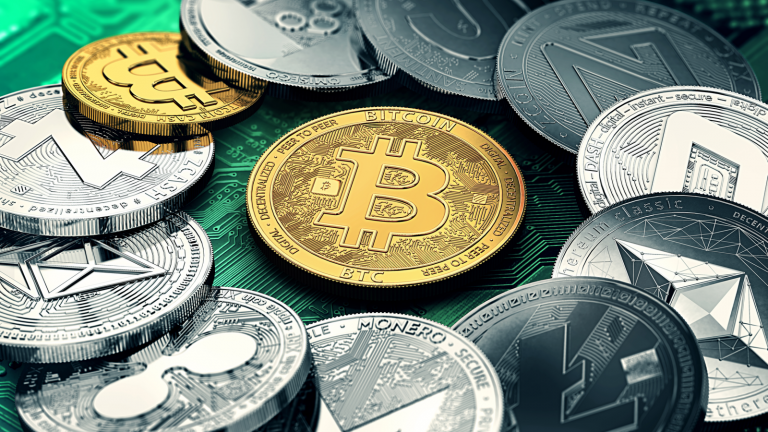Cryptos to buy are once again gaining interest. However, certain investors want to stay away because of extreme volatility. In 2022, many digital asset failures, implosions, and frauds caused the crypto market to lose 63% of its value.
On a brighter note, crypto prices have increased over 50% year-to-date through April 10. The fluctuations highlight the topsy-turvy nature of the industry.
Bitcoin (BTC-USD) remains the biggest cryptocurrency in the world. Ethereum (ETH-USD) and other virtual currencies also contribute to developing decentralized financial systems.
These two usually dominate discussions surrounding the sector. However, that does not mean there are no other options for investment. Encouraging economic data is now permeating the economy, and traders are noticing.
If you’re not ready to tolerate such drastic fluctuations, owning cryptocurrencies may not be for you. But if you are willing to take on the risk, the vast number of coins available can be overwhelming. To simplify your decision, here are three of the top cryptos to buy purchasing now:
| DOT-USD | Polkadot | $6.60 |
| MATIC-USD | Polygon | $1.14 |
| ADA-USD | Cardano | $0.42 |
Polkadot (DOT-USD)

Polkadot (DOT-USD) is a proof-of-stake cryptocurrency that promotes interoperability among other blockchains.
The protocol integrates permissioned and permissionless blockchains and oracles, allowing for seamless collaboration under a single system. Polkadot’s core component, the relay chain, facilitates the interoperability of diverse networks.
The platform’s parachains enable parallel blockchains with their tokens intended for specific use cases.
Gavin Wood, an Ethereum co-founder, authored Polkadot’s white paper in 2016. The following year, he co-founded the Web3 Foundation with Peter Czaban, a non-profit organization dedicated to advancing Polkadot. Robert Habermeier, a blockchain research and development expert, is also a Polkadot co-founder.
Following the sale of DOT tokens in October 2017, the Web3 Foundation faced a setback when their ETH token wallet was hacked. The result was roughly $90 million in funds being locked. In 2019, the foundation conducted a private token sale to recoup the losses.
Polkadot’s rollout took several stages, with the first network version launched on May 26, 2020. The network achieved its full launch on December 17, 2021, by activating its first five parachains.
Unlike Ethereum, Polkadot allows developers to create their blockchain while utilizing the security of Polkadot’s chain. This concept, known as shared security, sets Polkadot apart from Ethereum, where developers must create security measures, leaving new and smaller projects vulnerable to attacks.
Developers also benefit from Polkadot’s transaction validation and network security, which the platform handles. Transactions are validated on Polkadot’s relay chain, allowing developers to concentrate entirely on their blockchain projects instead of constructing a secure transaction validation system.
Polygon (MATIC-USD)

Polygon (MATIC-USD) has emerged as one of the biggest cryptocurrencies by market cap, excluding stablecoins, with a market cap of $10.13 billion.
The future success of Polygon hinges on its adoption and continuous utilization of the Ethereum network. Polygon aims to augment Ethereum’s capabilities as a scaling platform, allowing it to support unlimited decentralized applications.
Despite a price decline in 2022, Polygon had a relatively successful year compared to its peers. This was because of many new partnerships with companies seeking to leverage the potential of blockchain technology.
In 2022, Meta Platforms (NASDAQ:META), Disney (NYSE:DIS), and Coca-Cola (NYSE:KO) were among the many companies that announced partnerships with Polygon, each seeking to explore innovative business models enabled by the power of blockchain technology.
One of the main reasons Polygon is a preferred partner is its compatibility with Ethereum, one of the most widely used blockchains. Polygon is a Layer 2 blockchain, primarily aiming to improve Ethereum’s speed and affordability. When Ethereum experiences, high traffic can become expensive and slow to use. By processing transactions on its blockchain and aggregating them before adding them to Ethereum, Polygon provides users with a cost-effective and efficient solution fully compatible with Ethereum.
This unique technology has positioned Polygon as one of the most sought-after blockchains. Hence, it comes as no surprise it is one of the top cryptos to buy.
However, as more companies seek blockchain technology, Polygon must handle an influx of users without sacrificing speed or increasing fees. It will be crucial for Polygon to maintain its competitive edge by continuing to innovate and enhance its capabilities.
Cardano (ADA-USD)

Cardano (ADA-USD) is a cryptocurrency that utilizes the “Ouroboros proof-of-stake” system, developed by engineers, mathematicians, and cryptography experts through research-based methods.
Charles Hoskinson, one of the five original members who founded Ethereum, co-founded the Cardano project following a disagreement with Ethereum’s direction.
Cardano’s blockchain is built on comprehensive experimentation and peer-reviewed research. The team has produced over 120 papers on blockchain technology, setting Cardano apart from leading cryptocurrencies and proof-of-stake peers.
Cardano is known as an “Ethereum killer” because of the possibility of its blockchain surpassing Ethereum. Cardano is still in its nascent stages. Although it has outpaced Ethereum in adopting the proof-of-stake consensus model, it has yet to catch up regarding DeFi applications.
Cardano aims to serve as the world’s financial operating system by creating DeFi products similar to Ethereum and addressing issues such as chain interoperability, voter fraud, and legal contract tracing.
In contrast to Ethereum, Cardano has a hard cap of 45 billion coins that will ever exist. Over three-fourths of the supply is already in circulation, minimizing overall dilution.
And if you want to keep exploring cryptos to buy, here is a great article offering a more expansive list.
On the publication date, Faizan Farooque did not hold (directly or indirectly) any positions in the securities mentioned in this article. The opinions expressed in this article are those of the writer, subject to the InvestorPlace.com Publishing Guidelines.
